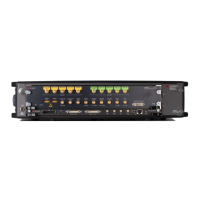For some waveform types, like e.g. radar pulses, huge pause segments with a static
output are required between the real waveform segments. The gap between the real
segments should be adjustable in a fine granularity
The idle command segment allows setting a pause between segments in a granularity
that is smaller than the sync clock granularity. A minimum length of this pause is
required (see section 8.21.6). The idle command segment is treated as a segment within
sequences or scenarios. There is no segment loop count but a sequence loop counter
value is required for cases where the idle command segment is the first segment of a
sequence.
The following table shows the granularity of the idle delay:
Limitations:
The logic that executes idle command segments uses some elements, which are
not in sync clock granularity. To guarantee the trigger to sample output delay or
the advancement event to sample output delay, these elements need to be reset
before accepting new trigger or advancement events. This requires the waveform
generation to be stopped for at least 3 sync clock cycles before being restarted by
a trigger or an advancement event. A violation of this requirement leads to an
unexpected output behavior for some sync clock cycles.
The sync marker output of the corresponding channel is directly generated by the
sequencer in the sync clock domain and is not shifted in sample granularity. So
some jitter between sample output and sync marker output might be observed,
when using idle command segments within a sequence or scenario.
Multiple adjacent idle command segments are not allowed. If the playtime of one
idle command segment is not sufficient, the overall required idle length can be
separated into multiple idle command segments where a normal data segment
providing the static idle value is put in between. Even this wouldn’t be really
necessary. One idle command segment (delay of up to 2^25 sync clock cycles) and
one additional small segment (e.g. length: 10 * segment vectors, loop count: up to
2^32) would provide an idle delay of more than 200 seconds in high speed mode at
12 GSa/s and should be sufficient for most applications.

